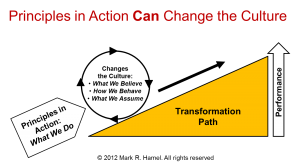 To borrow a phrase that was borrowed by Pope Benedict XVI for his (in)famous 2006 Regensburg lecture, “There is no compulsion in lean.”
To borrow a phrase that was borrowed by Pope Benedict XVI for his (in)famous 2006 Regensburg lecture, “There is no compulsion in lean.”
OK, the pontiff didn’t really use the word “lean” (rather it was “religion”), but the underlying sentiment is much the same.
How so?
Well, you can’t FORCE someone to embrace lean with both heart and mind.
In the end, it must be an intrinsic thing. Organizations achieve and sustain transformative levels when folks “get it,” and “live it.” Meaning, when BOTH their intellect and will are engaged.
The foundational principles of lean are humility and respect for the individual. As such, we must respect each and every person’s free will while doing our level best to teach them.
Free will is pretty much a blind faculty. It’s got to be directed by the brain.
Of course, you can force someone to DO lean things – follow standard work, participate in kaizen activities, respond to abnormal conditions, etc.
However, this is purely extrinsic in nature and therefore is not transformative…at least initially. (I guess the spouses in a number of arranged marriages end up falling in love.)
Compelling people to do things that they otherwise might not want to do is often required in life (hey, son/daughter feed the dog, take out the trash…), including business.
Especially in business.
When a company seriously undertakes a lean transformation, there are certain expectations around adherence and behavior. If employees do not meet the expectations, they must be coached by technically competent believers. Sometimes, eventually, they must leave the organization, voluntarily or involuntarily.
In a derivative of Pascal’s wager…you can act yourself into a new way of being. Through acting lean, meaning engaging in lean actions, folks can start to get it.
The risk obviously, is that these “practitioners” end up just practicing the tools and maybe the systems. That can often be superficial, without real, lasting buy-in.
Understanding and embracing lean principles (the “why”) takes reflection, and deep, consistent coaching.
Presuming that folks have some insight into the technical side (the “how”), and have the ecosystem for improvement (like a robust lean management system and good lean leadership behaviors), the litmus test for whether an organization is bridging the lean compulsion realm to the lean transformation realm is DAILY kaizen.
Yes, management driven kaizen typically manifests itself in kaizen events as pulled by value stream improvement plans and the like. This is system driven kaizen. Not a bad place at all.
But, it’s nearly impossible to fake daily kaizen.
How can you fake voluntary kaizen in the form of (implemented) employee suggestions, kaizen circle activities, and the buzz of countermeasure discussions during daily reflection meetings?!?
My answer is, you can’t.
This extract of the Shingo Prize Model Guidelines, specifically the Examples of Ideal Behaviors for Continuous Process Improvement, drives it home:
- "Every associate in every part of the organization is engaged every day in using the appropriate tools of continuous improvement to eliminate waste and maximize value creation.
- Associates everywhere seek to understand the principles (the why) behind the tools (the how); they learn and use that knowledge to continuously improve the application of the tools.
- All associates demonstrate the courage and integrity to tell the truth, stop production, and be accountable for defects they observe or create themselves.
- Associates share their expertise in developing best practice standard work and demonstrate the discipline to follow it until a better way has been developed."
So, in the end, there is no true compulsion in lean.
Which is another reason why lean transformations are so darned hard to pull off and why it’s so special when they do happen.
Related posts: The Intrinsic Discipline of the Lean Leader, 12 Narrow Lean Gates, Guest Post: “Magical Thinking”
